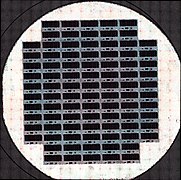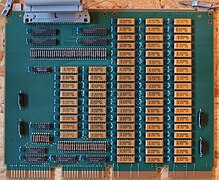U61000
U61000 , in the press also Megachip called, was a 1 Mbit - DRAM -Schaltkreis from the Democratic German Republic (GDR). It was developed from 1986 in the VEB Research Center Microelectronics Dresden (ZMD) of the VEB Carl Zeiss Jena and was to be transferred to series production in 1990 in the ESO III plant of the VEB Microelectronics "Karl-Marx" Erfurt (KME). The U61000, which corresponded to the international type 511000, was manufactured in CMOS technology with a structure width of 1.2 µm and housed in an 18-pin DIL -Plast- (U61000D) or ceramic housing (U61000C). Internally it was organized with 1024K × 1 bit and had a RAS access time of 100 to 120 ns. The memory chip was to be used primarily in the Robotron K 1820 , K 1840 and EC 1835 computers .
history
With the resolution of February 11, 1986 by the SED leadership for the further development of microelectronics ("Mikron" project) in the GDR, the ZMD was given the task of developing a 1 Mbit memory circuit within three years and going into series production in 1990 to introduce. Building on the experience gained in the production of 64 kBit (U6164) and 256 kBit (U61256) DRAM circuits based on Toshiba technology , the development of the 1 Mbit memory circuit was started in Dresden. For this purpose, Dept. XIV (SWT) of the GDR's foreign intelligence service in the Ministry for State Security procured documents on the necessary VLSI production technology from Siemens . Siemens had previously licensed this technology from Toshiba for its own products. Siemens engineers had great difficulties to overcome when it came to mass production. According to the developers at ZMD, these documents were not used because these papers "... did not fit into our concept, which was heavily tailored to the Jena equipment ... The Stasi was very disappointed that the scientists ignored their work so disgracefully." Subsequent research the CIA at the Siemens chip developers could not substantiate the suspicion that the Dresden megabit chip was built with the help of Siemens documents.
Because of the CoCom technology embargo , the technical special equipment (TSA) required for production and the computer technology required for development could not be legally purchased on the world market. Therefore, much of the TSA as wafer steppers , electron beam writer , LPCVD coating yard, Ionenstrahlätzer and assembly lines at Carl Zeiss Jena and VEB Elektromat Dresden designed and built himself. Other important TSAs such as plasma etchers and high-current implants were originally intended to be obtained from the Soviet Union as part of a cooperation agreement . However, since the Soviet Union could not deliver the systems in the required quality, the SED leadership decided to use these TSA and powerful computers for circuit development contrary to the legal provisions of the Federal Republic of Germany ( Foreign Trade Act , Military Government Act No. 53 "Foreign exchange management and control of goods traffic" the three western occupying powers) and other western states via the Commercial Coordination (KoKo) of the Ministry of Foreign Trade. These imported systems still had to be significantly optimized and technically changed by the engineers at ZMD in order to be able to use them for the planned purpose.
On August 10, 1988, the test devices were able to demonstrate the first functional and error-free development samples of the 1 Mbit memory chip. These samples were presented to Erich Honecker on September 12, 1988 (see picture). In 1988, the research center collective was awarded the GDR national prize for developing the memory circuit. The U61000 received a gold medal at the Leipzig spring fair in 1989.
In 1988 around 5,000 samples of the U61000 were produced on the ZMD pilot line. In 1989, another 30,000 megabit circuits followed, which were manufactured with a yield of up to 20%.
The development work was ended in the spring of 1990, a transition to series production in the newly built ESO III plant of KME Erfurt no longer took place because the TSAs were not available in the required number. An already planned development of a 4-Mbit memory circuit was no longer started, because there were also hardly any requirements for later mass production.
With the abolition of the technology boycott in the course of monetary, economic and social union in July 1990, an economical production of this memory circuit was no longer possible, as users from the domestic computer industry could now obtain the equivalent types on the world market at significantly lower prices and in large numbers.
gallery
U61000D under glass (today in the Deutsches Museum Bonn )
literature
- Microelectronics data book general overview. Info-Verlag electronic, Berlin 1990, p. 257.
- Collective of authors: User manual K 1821 / K 1822. VEB Robotron-Elektronik Dresden, November 1989.
- Collective of authors: Technical manual memory module MSC20. VEB Robotron-Elektronik Dresden, December 1989.
- Detlef Borchers: Unrestrained optimists: 30 years of the GDR chip U61000 . heise.de, September 12, 2018.
Web links
- The megabit chip in the Deutsches Museum Bonn
- U61000 at www.robotrontechnik
- Photos from the megabit memory
- State mandate: "Maximum integration" Thuringia and the microelectronics program of the GDR
- 2015 - 19th Leibniz Conference 2015 - Digital Revolution and Industry 4.0 - 25 years of development completion of the mega memory in Dresden Development of the megabit memory U61000, 1986 to 1990
- Preliminary fair prospectus of the U61000 from February 1989. archive.org
Individual evidence
- ↑ Horst Müller, Manfred Suss, Horst Vogel (ed.): The industrial espionage of the GDR. edition ost, Berlin 2009, ISBN 978-3-360-01099-5 .
- ↑ Siemens is lagging behind with Megachip . In: Computerwoche , February 13, 1987.
- ↑ Silicon Saxony e. V. (Ed.): Silicon Saxony - the story . edition Dresden 2006, ISBN 978-3-9808680-2-0 , p. 73.
- ↑ Silicon Saxony e. V. (Ed.): Silicon Saxony - the story . edition Dresden 2006, ISBN 978-3-9808680-2-0 , p. 79.
- ↑ Silicon Saxony e. V. (Ed.): Silicon Saxony - the story . edition Dresden 2006, ISBN 978-3-9808680-2-0 , p. 75.
- ^ Gerhardt Ronneberger: Code name "Saale", high-tech smuggler under Schalck-Golodkowski. Dietz Verlag Berlin 1999, ISBN 3-320-01967-8 .
- ↑ Silicon Saxony e. V. (Ed.): Silicon Saxony - the story . edition Dresden 2006, ISBN 978-3-9808680-2-0 , p. 76.
- ↑ What became of Honecker's Megachip. Saxon Newspaper , March 23, 2015
- ↑ Race against time (60) - The mega project or the uninhibited optimists. Television of the GDR , broadcast on September 16, 1988.
- ↑ a b c Heiko Weckbrodt: Mass production of GDR megabitchip was “not possible at all”. Retrieved September 11, 2011 .
- ^ Hans W. Becker: Looking back: Artwork and mask making in Dresden for the East German megabit chip project. 20th European Conference on Mask Technology for Integrated Circuits and Microcomponents. Edited by Uwe Behringer. FW Proceedings of the SPIE, Volume 5504, 2004, ISBN 978-0-8194-5437-9 , pp. 75-85.
- ↑ Silicon Saxony e. V. (Ed.): Silicon Saxony - the story . edition Dresden 2006, ISBN 978-3-9808680-2-0 , p. 80.









